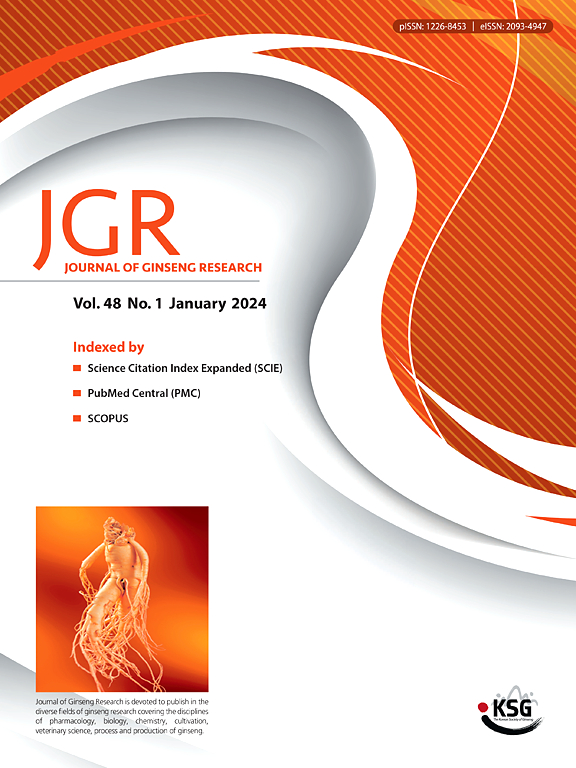Korean Red Ginseng relieves the inflammation and oxidative stress induced by pseudo-typed SARS-CoV-2
IF 6.8
2区 医学
Q1 CHEMISTRY, MEDICINAL
引用次数: 0
Abstract
Background
Developing antiviral agents against severe acute respiratory syndrome coronavirus 2 (SARS-CoV-2) has been a global goal since the Coronavirus Disease 2019 (COVID-19) pandemic emerged in 2019. Korean Red Ginseng (KRG), recognized for its immunomodulating and antiviral properties, may be effective against SARS-CoV-2. Therefore, we aimed to investigate the efficiency of KRG in a human angiotensin-converting enzyme 2 (hACE2)-expressing mouse model infected with pseudo-typed SARS-CoV-2 (PSV).
Methods
The lung injury score was assessed using H&E staining, and the immune cell population shift in the lung and spleen was observed through flow cytometry. Serum IgM and IgG concentrations were quantified using enzyme-linked immunoassay (ELISA). Pro-inflammatory cytokine levels were measured by cytometric bead assay (CBA) and polymerase chain reaction (PCR). Additionally, the expression of NLR family pyrin domain containing 3 (NLRP3) and inflammation-related transcription factors was detected by immunoblotting. RNA-sequencing and antibody array assays reconfirmed gene expression in inflammation and oxidation.
Results
KRG extract was most effective in treating lung injuries and serum IgM and IgG levels. Also, immune cells, including neutrophils, were regulated in the lungs, and tumor necrosis factor-alpha (TNF-a) levels were reduced. NLRP3 and phosphorylated nuclear factor-κB (NF-kB) and activator protein 1 (AP-1) were downregulated. Heme oxygenase-1 (HO-1) expression was increased, indicating that KRG extract has antioxidant properties. RNA-sequencing and antibody array assays revealed that KRG extract regulates the expression of genes associated with inflammation and oxidative damage.
Conclusions
This study demonstrates that KRG extract may suppress PSV-induced inflammation and oxidative stress, making it a viable antiviral functional food.

高丽红参对假型SARS-CoV-2诱导的炎症和氧化应激有缓解作用
自2019年冠状病毒病(COVID-19)大流行出现以来,开发针对严重急性呼吸综合征冠状病毒2 (SARS-CoV-2)的抗病毒药物一直是全球目标。韩国红参(KRG)具有免疫调节和抗病毒特性,可能对SARS-CoV-2有效。因此,我们旨在研究KRG在表达人血管紧张素转换酶2 (hACE2)的小鼠感染伪型SARS-CoV-2 (PSV)模型中的效率。方法采用H&;E染色法评价大鼠肺损伤评分,流式细胞术观察肺、脾免疫细胞群变化。采用酶联免疫分析法(ELISA)测定血清IgM和IgG浓度。采用细胞计数法(CBA)和聚合酶链反应(PCR)检测促炎细胞因子水平。免疫印迹法检测NLR家族pyrin domain containing 3 (NLRP3)及炎症相关转录因子的表达。rna测序和抗体阵列分析再次证实了基因在炎症和氧化中的表达。结果丹参提取物对肺损伤及血清IgM、IgG水平均有较好的治疗效果。此外,包括中性粒细胞在内的免疫细胞在肺部受到调节,肿瘤坏死因子- α (TNF-a)水平降低。NLRP3、磷酸化核因子-κB (NF-kB)和激活蛋白1 (AP-1)下调。血红素加氧酶-1 (HO-1)表达升高,表明KRG提取物具有抗氧化作用。rna测序和抗体阵列分析显示,KRG提取物调节炎症和氧化损伤相关基因的表达。结论KRG提取物具有抑制psv诱导的炎症和氧化应激的作用,是一种有效的抗病毒功能食品。
本文章由计算机程序翻译,如有差异,请以英文原文为准。
求助全文
约1分钟内获得全文
求助全文
来源期刊

Journal of Ginseng Research
CHEMISTRY, MEDICINAL-INTEGRATIVE & COMPLEMENTARY MEDICINE
CiteScore
11.40
自引率
9.50%
发文量
111
审稿时长
6-12 weeks
期刊介绍:
Journal of Ginseng Research (JGR) is an official, open access journal of the Korean Society of Ginseng and is the only international journal publishing scholarly reports on ginseng research in the world. The journal is a bimonthly peer-reviewed publication featuring high-quality studies related to basic, pre-clinical, and clinical researches on ginseng to reflect recent progresses in ginseng research.
JGR publishes papers, either experimental or theoretical, that advance our understanding of ginseng science, including plant sciences, biology, chemistry, pharmacology, toxicology, pharmacokinetics, veterinary medicine, biochemistry, manufacture, and clinical study of ginseng since 1976. It also includes the new paradigm of integrative research, covering alternative medicinal approaches. Article types considered for publication include review articles, original research articles, and brief reports.
JGR helps researchers to understand mechanisms for traditional efficacy of ginseng and to put their clinical evidence together. It provides balanced information on basic science and clinical applications to researchers, manufacturers, practitioners, teachers, scholars, and medical doctors.
 求助内容:
求助内容: 应助结果提醒方式:
应助结果提醒方式:


